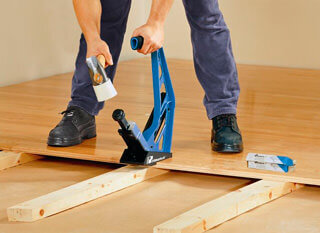Installation Methods
In general there are three types of installation methods that can be used to install your hardwood flooring:
- Secret Nailing
- Installation as a Floated Floor
- Gluing Down to the subfloor
Secret Nailing
To secret nail a flo or board, there has to be wooden joists or wooden subfloor to nail the boards on. The ‘secret’ part of this method is that the nails are hidden from sight; this is because they are driven through the tongue that runs down the side of the flooring board. The tongue is then slotted into the groove on the adjacent board, hiding the nails from view.
or board, there has to be wooden joists or wooden subfloor to nail the boards on. The ‘secret’ part of this method is that the nails are hidden from sight; this is because they are driven through the tongue that runs down the side of the flooring board. The tongue is then slotted into the groove on the adjacent board, hiding the nails from view.
For this method you need flooring boards of at least 21mm thick. This method is popular for installing solid and engineered hardwood floors. It is easy, fast and clean to install hardwood flooring using this method. The main disadvantage of this method is that, it can be noisy when walking on it because there is no acoustic barrier between the subfloor and the new hardwood floor, unlike in a floating or glued system. If nailed to an existing uneven surface the floor will eventually start squeaking due to the movement. This is also the cheapest method but also the oldest and in our opinion, this method is outdated.
Floating Floor
In this method, a layer of underlay between 2 – 4mm is laid and taped down to the existing sub floor using a special underlay tape. Then the new floor is laid on top of the underlay and fit the tongue of the board into the groove of the next plank; these are then generally glued together using PVA glue.
The skirting around the perimeter of the room will need to be removed, and the existing skirting reinstated on completion. This is important because the skirting is the only thing that holds down the floors. If the area or building is new, the sub floor should have a structural ply and the area should be completely flat. Failure to have a level subfloor when using this method would leave the boards with a bouncy effect when walking over an area that is not level.
Gluing Down
Wood flooring can also be installed using the glue-down method. This is especially popular when installing solid parquet flooring on concrete sub-floors. Additionally, engineered wood flooring can use the glue-down method as well. A layer of adhesive is placed onto the sub-floor using a trowel similar to those used in laying ceramic tile. The wood flooring is then laid on top of the glue and carefully placed using a rubber mallet to create a level floor. Often the parquet flooring or wood flooring panels will require sanding and re-finishing after the glue-down installation method due to the small size pieces.
The Gluing down method is the most professional way of installing wood floors, and it is now widely accepted. But we highly recommend the use of an elastic flexible adhesive. Even if this method is the most expensive, it is the best of the three. This is because it gives you a full and secure bond, which dampens the impact of walking or any airborne sounds. Also, the subfloor doesn’t have to be completely level; this elastic adhesive allows you to alter the sub floor levels greater than 2 or 3mm, without having to undertake the messy task of using a levelling compound.
The installation method to be used depends mainly on two things:
- The installation system of the material that you have chosen.
- The type of the subfloor that you have on your property.
This chart is designed to show you the possible fixing methods, but always consult with a 3 Oak Expert.